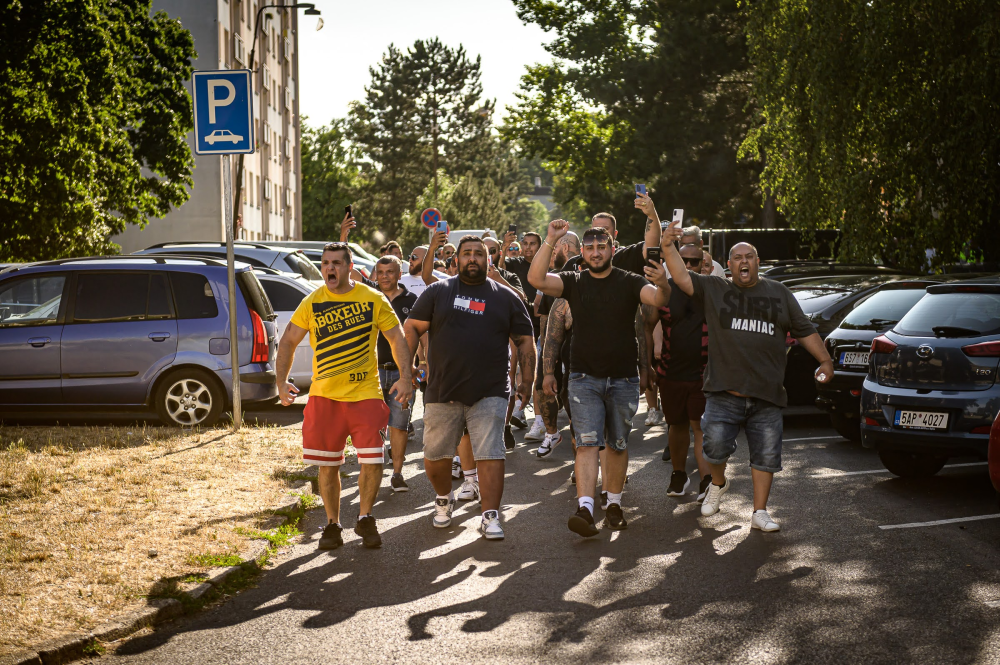It was only after 2015 that they found themselves in the role of those who spread disinformation, when anti-refugee disinformation was spread by part of the Roma population. With the onset of the COVID-19 pandemic, disinformation began to circulate more widely among the Roma. After Russia's attack on Ukraine, this trend has been confirmed, and disinformation about “Ukrainian neo-Nazis" is spreading among the Roma. In many cases, exaggerated or inaccurately described incidents between the Romani people and Ukrainians have also led to increased tensions.
Disinformation about the Roma
The Roma were a frequent target of disinformation, especially between 2006 and 2016, when false news about them circulated mainly on social media and in the mass media. It is enough to recall the constantly repeated disinformation that Romani people have free entrance to swimming pools in the summer, or the regularly appearing untruth about free medicine for Romani people.
One of the most well-known examples, and in a way a breakthrough case, of the dissemination of false information about Romani people in the media, the case of the well-known political tabloid Parlamentní listy is often cited. They published a false report about a Romani treasurer who had robbed a newly founded Romani party. Parlamentní listy was eventually forced to admit that it had published a lie. The misinformation was then picked up by some mainstream media without any verification, but they learned from the situation and subsequently changed some of their editorial practices. Between 2011 and 2012, fabricated or exaggerated attacks by Romani people began to appear in the media. These cases culminated in the case of the 15-year-old Ukrainian boy from Břeclav, which some have described as one of the biggest lies in the history of Czech journalism. Petr, then 15, from Břeclav (a mid-sized town in southern Czech Republic), was injured while showing off in front of his friends. Because he was afraid of his mother, he made up a lie that he had been beaten by a group of Romani people to whom he had not given a cigarette.
More than 2 000 far-right supporters arrived in Breclav and several hundred of them attempted to infiltrate the Roma-populated part of the town. Other Roma faced open racism and hatred. The media initially accepted the boy's version. After it became clear that he was lying, the major media became more attentive to these cases and the number of misleading articles dropped.
Some Romani people as disinformants: the migration crisis and Covid-19
With the onset of the migration crisis in 2015, the phenomenon of the disinformation spread by some Romani people began to emerge. However, the anti-refugee hoaxes did not spread among Romani people on a massive scale, but rather in the form of single posts on social media.
Roma began spreading disinformation to a greater extent only with the COVID-19 pandemic, which contributed to many Roma refusing vaccination. Many rumours and false stories circulated among the Roma population on Facebook about the harmful and allegedly fatal consequences of vaccination, or about Roma receiving a different type of vaccine than the majority.
Consequently, vaccination rates were lower among the Roma population compared to the majority, which subsequently led some Roma activists to engage in refuting such disinformation.
2022: Double standard towards Roma refugees from Ukraine contributed to the spread of disinformation
But what came after Russia invaded Ukraine was not expected by many experts. As recent research for the Czech Radio news website iROZHLAS.cz shows, resistance to disinformation is directly proportional to trust in the system, government and justice, which is very low among Romani people. The approach of the "system" towards Roma refugees in 2022 has confirmed this among many Roma.
Nearly everyone has seen the footage from Praha hlavní nádraží (the Prague Main Railway Station), where hundreds of Romani women and children fleeing the war in Ukraine lay on the floor of the station hall. The double standard in the treatment of these refugees was another nail in the coffin of trust in the state. The Roma were once again second-class citizens.
The Kremlin propaganda soon took advantage of the situation and disinformation about Ukrainian neo-Nazis began to spread massively among the Roma. "Clean Ukraine of Nazis" was one of the first slogans with which President Putin launched the occupation of Ukraine. The same lie was often repeated in various discussions among the Roma, and photos of, for example, President Volodymyr Zelensky giving the Nazi salute were attached as evidence.
Given that Ukraine faced right-wing extremists who attacked Roma or were in the Azov battalion between 2014 and 2020, refuting this disinformation was particularly difficult. It was rather challenging to explain that Ukraine's officials have been clearly speaking out against these radical groups since 2014, and the Ukrainian Ministry of Interior had already ordered their disarmament in 2014.
2023: Disinformation about attacks on Roma by Ukrainians
Romani people have not only seen Romani refugees lying on the floor at Prague’s Main Railway Station, but they have also begun to notice that a large number of housing options have suddenly appeared in the Czech Republic. Ukrainian refugees who were not of Romani origin began to leave the residential hotels after their temporary stay and managed to find decent housing. Czech Roma stayed in the residential hotels, which contributed to increasing frustration and negative attitudes against Ukrainian refugees. These negative attitudes grew throughout Czech society.
A hot summer in relations between some Roma and Ukrainians was approaching. The trigger was an unfortunate tragic event that occurred on the 10th of June in Brno (the second largest city in the Czech Republic). Several people got into an argument near the Přístaviště tram stop and a fight broke out, during which a foreigner from Ukraine injured two men with a knife. One of them, a 23-year-old Romani youth, later succumbed to his injuries in the hospital.
All the frustration bubbled to the surface. In the first moments, neither the police nor government officials understood what was happening among the Roma community, and their initial rhetoric, which treated the reporting of the incident as if someone had stolen bread from a shop, was inadequate. Interior Minister Vít Rakušan did not comment on the rioting part of the Romani community until three days later, at the urging of Romani activists, which can be considered very late in the age of social media.
Fear of organized attacks on Romani people, which were triggered by false and inflated information on social media, added to the distrust in the system and frustration with the preference of Ukrainian refugees over Romani people. The minister is not trusted by the Roma, and some of them were preparing to organize demonstrations alongside extremists who took similar action against the Roma in 2011-2012.
"The frustration stems from the lax approach of state authorities in the case of the Roma, the structural antigypsyism we encounter in most institutions, starting from local, state and international institutions. One huge problem - structural antigypsyism!" Tomáš Ščuka, a political scientist and member of the Government Council for Romani Affairs, and Michal Mižigár, a historian and Romani scholar, told news server Romea.cz.
In the meantime, the so-called "lajfkaři", a group of 7 to 10 Romani influencers has crystallized on social media, and in their frequent broadcasts they express their opinions on current events that primarily concern Romani people. They began to incite Romani people against Ukrainians, inflated certain events and released a series of disinformation into the public space.
From the children's conflict in Přerov to the demonstration in Krupka
On Monday, 10 July, more than 100 Romani people came to the police station in Přerov and demanded that officers take a criminal complaint from the mother of a little girl who was allegedly threatened with a knife by two Ukrainian children that afternoon. The Romani people's distrust of the system, combined with the not-so-happy actions of the police officer who failed to explain to the Romani mother that her report had been received by the police and that they were indeed investigating the case, led to an unnecessary escalation. In the end, it turned out that it was only a verbal conflict between the children.
The Roma "lajfkaři" seized on this incident as well and spread it with a clear message: "Even Ukrainian children are already attacking our Romani children with knives."
The case in Přerov was closely followed by a conflict in Krupka, North Bohemia, on 16 July. The footage, which immediately began circulating on social media, shows the intervention of municipal officers who detained two foreigners. According to locals, the men had previously sexually harassed several Romani children. "The Ukrainians locked about 3 or 4 children in the basement, where they wanted to rape them," one of the Romani people claimed on Facebook directly from Krupka.
After pressure from NGOs and Romani activists, the police began to react. The very next day it unequivocally refuted that they were not in fact citizens of Ukraine. Later, it turned out that this case was also described in the initial stages by “lajfkaři" in a very distorted way.
 Demonstration in Krupka. Photo by: Petr Zewlakk Vrabec
Demonstration in Krupka. Photo by: Petr Zewlakk Vrabec
Combination of prevention and repression
In the second half of July, the situation began to calm down. This was due to a combination of repressive and preventive measures.
The police publicized cases in which they charged alarmists on social media with criminal offences. An example of this was an incident in Přerov, where police officers very quickly tracked down a woman who claimed on Facebook that she had been attacked by Ukrainians, and that they wanted to kill all Roma. Shortly before that, within a few hours, police officers had uncovered another suspect who had shared false information about the stabbing of an 11-year-old boy by Ukrainians in Sokolov.
Czech Govt Commissioner for Roma Minority Affairs, Lucie Fuková, and other experts from ministries and non-profit organizations have also tried to combat the spread of disinformation among Romani people. They formed a working group that quickly responded to the disinformation and de-escalated the situation at the local level.
In order to calm down any tensions and unrest in towns or cities, the group created a "ten commandments for crisis communication" for town halls and other governmental institutions. The set procedure is intended to help prevent or dampen conflicts and prevent the spread of disinformation and the abuse of the situation by extremists.
An example of good practice is the prompt response of institutions and the media to the October incident in Rýmařov in the Bruntál region, when an 18-year-old assailant attacked a Roma man two years older than him. In cooperation with the news server Romea.cz, police quickly confirmed that the attack was not an attack by a group of Ukrainians. In addition to Lucie Fuková, the town's mayor has also stepped in and begun communicating with the local Romani community and has met with the family of the young man who was attacked in order to defuse the escalated situation. "We have been monitoring the entire situation since the beginning and are addressing it in cooperation with the Czech Police and the family of the man who was attacked," Mayor Luděk Šimko said in a statement on the town's official website.
The disinformation is having a negative impact on the Romani community and on society as a whole. As was demonstrated in 2011-2012 or in the summer of 2023, this has led to misunderstandings, fear, hatred and violence. The Roma feel threatened and discriminated against, they distrust the system and the government of the Czech Republic, which they very often blame for the bad situation. This is one of the reasons why some of them took part in the anti-Ukrainian protests and demonstrations this summer.
To learn more about ways to counter disinformation, register to the Hive Mind free self-paced course:
Background photo of demonstration in Krupka by: Petr Zewlakk Vrabec
This piece was published in partnership with VIA Association

